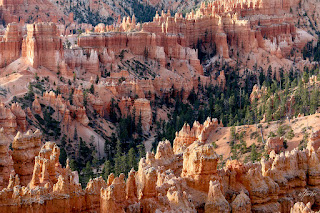These are the Spanish Peaks viewed from Co Rd 450 just S of US-160, NW of La Veta. They're impressive, right? So impressive, I decided West Spanish Peak was probably Pike's Peak.
And that was fine the closer I got (it kept getting more impressive) but eventually, after I passed through La Veta with no references there at all to Pike's Peak, I decided it had to be some other mountain. I've since looked up Pike's Peak and if I'm ever in the area (the right area) I will probably check out the real Pike's Peak.
This view of the mountain reminded me of my last trip to Big Bend (in spite of all the greenery). Remember in my Big Bend post I told you about magmatic dikes? Those igneous intrusions into the earth's crust that were left when layers of other, softer rock eroded? That's what got my attention when I saw this view. West Spanish Peak is, of course, the mountain center stage. And, between us are a 7920 ft ridge hiding the mountain's lower reaches, then the Cucharas River, and finally CO-12, winding south in Rilling Canyon.
A few miles down the road I came upon The Devil's Stairsteps. I thought, "cool, they're all over the place." And that was satisfactory - until I googled said Stairsteps. The Colorado Geological Survey made things a little more complicated - well, suggested it was a little more complicated than I had thought. I think I understand what they're telling me, but the explanation doesn't quite make sense (to me), so I'll leave it at that for now. Maybe I'll get back to this somewhere down the pike, but it's too much to take on just now.
This is a farm/ranch alongside the highway in Cottonwood Canyon, two and a half miles north of the town of Cuchara. Nice.
This is the view looking west (and uphill), south of Cuchara still on CO-12, just a mile SE of Boyd Mt (which is out of frame to the right). That's all, I just liked the clouds.
And, finally, the view looking west across North Lake. Thus far I'd been well pleased with my chosen route through Cuchara. But this lake is North Lake and you'd expect the next similar size lake just a mile and a half south down the road to be South Lake, Right? Wrong! That lake is Monument Lake.
First the dikes, then Monument Lake - I'm too tired for this. My vacation is over - now I'm just driving home. Get some sleep in Dalhart tonight, have brunch with my cousin Rachel in Amarillo tomorrow, drive back to Austin and sleep for a week. Oh, yeah - then write the blog posts. Done!

























































